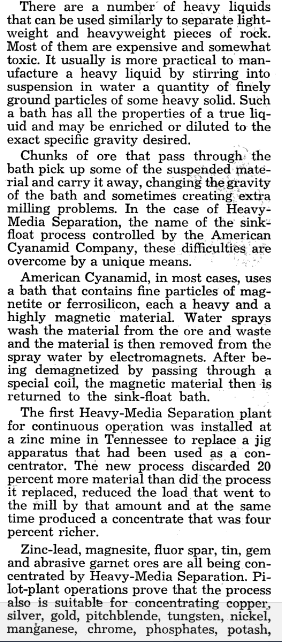Table of Contents
The Sink and Float Separation Process is an alternative to the progressive depletion, during the last quarter century, of ores which could be economically treated by the old methods of gravity concentration necessitated the development of more efficient methods of concentration, the most successful and widely used of these methods being the Flotation Process. But during the past few years millman have realized that there is still a place for improved gravity concentration in a modern flowsheet, either in conjunction with flotation or alone. This is the result of the commercial application of the more refined and accurately controlled method of gravity concentration known as the Sink and Float Process.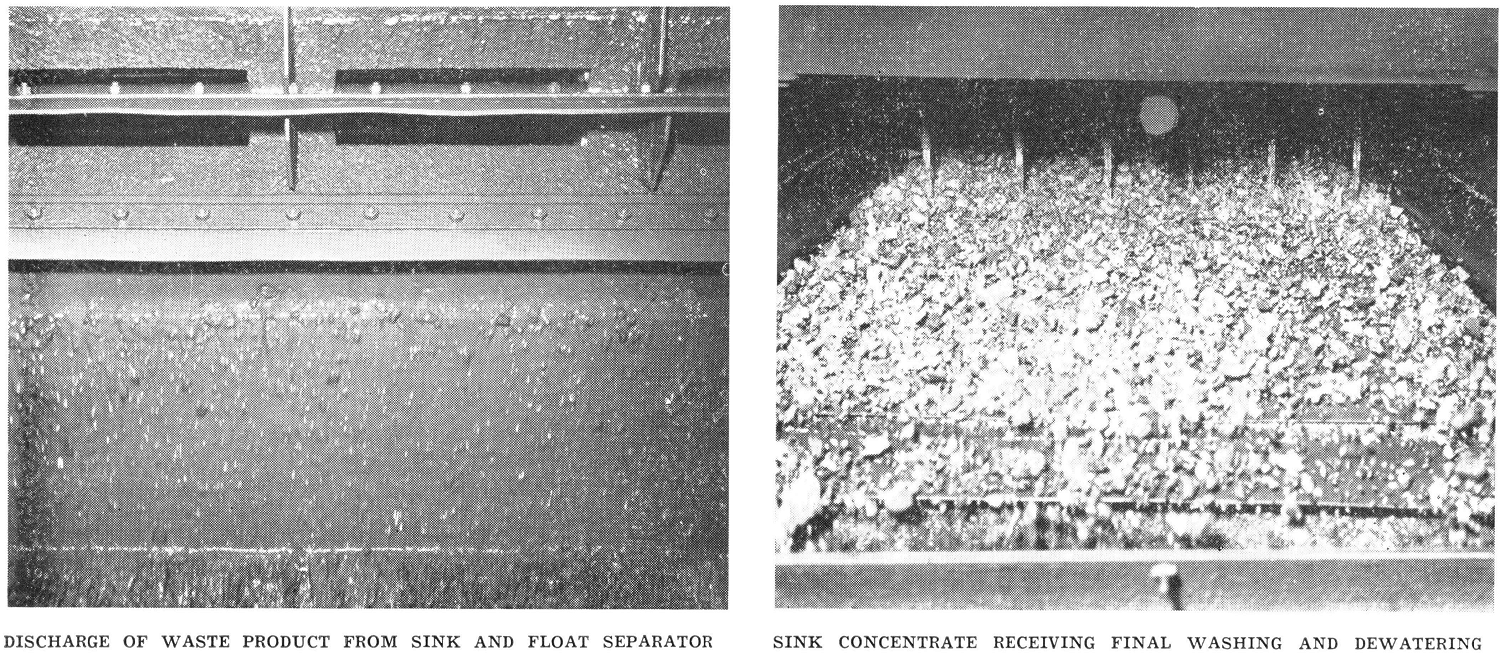
Sink and Float PROCESS History and Development
For many years there have been effected in laboratory work separations of ore particles of different specific gravities through immersion of the mixed particles in a medium of a true heavy liquid with a specific gravity intermediate between the specific gravities of the heavy and light particles to be separated. The particles of lower specific gravity float on the surface of the medium, while the particles of higher specific gravity sink to the bottom. The two types of particles are removed separately from the medium and a separation of particles achieved according to the individual specific gravities. The principle hardly needs elaboration. Its application to ore dressing depends upon the fact that the specific gravity of valuable minerals generally differs from the specific gravity of the worthless gangue with which it is associated and from which substantial portions can usually be freed by crushing.
The earlier processes of this type employed suspension media which were of low kinetic stability; that is to say, the solids of the media would rapidly settle out unless kept in suspension by some form of agitation. In 1928 the deVooys Process was introduced for the separation of shale from coal. This process employs as “medium” a practically stable suspension of barytes and clay in water whose high kinetic stability makes it possible to dispense with stirring devices for maintaining uniformity of suspension. Thus the separation takes place in a quiescent medium—a most important point, since currents in the medium are bound to interfere to a greater or lesser degree with the accuracy of the gravity separation taking place in the medium.
Since 1931, commercial deVooys plants have been installed capable of handling over millions of tons annually. Utilizing the experience of their associated company with the deVooys plants for coal, employing relatively low separating medium densities, Huntington, Heberlein & Company, Ltd., Whitford, Holywell, North Wales, Great Britain, perfected the Sink and Float Process for higher separating medium densities with the resultant broadening of the field to include other non- metallic as well as metallic ores.
QUIESCENT SEPARATION
The speed at which the separation of the “sink” from the “float” particles takes place depends upon the weight of individual particles and also on the difference in specific gravity between the particles and the medium. Thus, the large or heavy particles sink fast, and separation of these from float particles is easily achieved while the smaller particles, or those with a small gravity differential from the medium, are not as readily separated. Comparatively large particles, viz., ½-inch in diameter, of marginal density (i.e., near the density of the separating medium) can fall through the separating medium at a speed as low as 1 ft. per minute. Smaller particles of similar marginal density will fall even more slowly. With such marginal density particles, true gravity separation is interfered with by disturbances or movements of the separating medium, hence the importance of quiescent conditions.
In practice the finer fractions of the ore are not subjected to Sink and Float treatment, as even under the best conditions the rate of separation would be uneconomically slow. If there are currents in the medium, this puts an even higher limit to the fine size of the ore which can be successfully separated.
The Sink and Float Process reduces medium currents to a minimum with the following benefits:
- Prevents interference with accuracy of separation by classifying effects.
- Reduces the fine size limit at which ore can be separated.
- Increases the recovery of particles of marginal density.
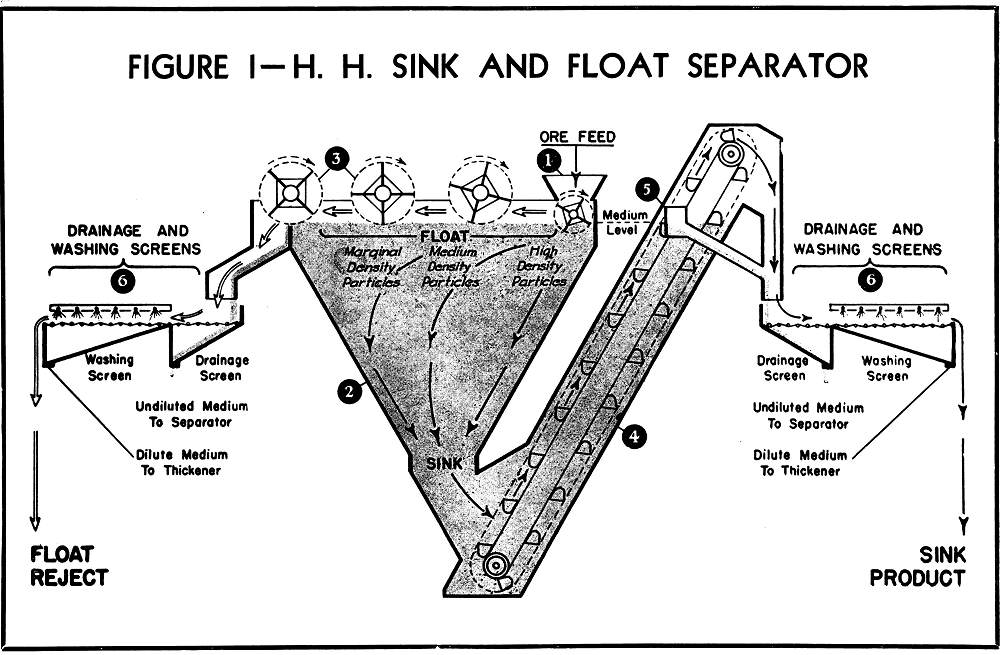
SIZE OF ORE FEEDING A SINK & FLOAT SEPARATOR
In the case of the so-called “metallic” ores the density of the separating medium is adjusted so that only those pieces of mineralized gangue float which carry a small particle of mineral. These lightly mineralized gangue particles are mixed with a large proportion of barren gangue so that the average assay of the float is not high. On the other hand, the heavily mineralized gangue pieces are found in the sink product, which is not generally high enough grade to be a finished product but is usually ground finer for further concentration. In operation the role of Sink and Float is to reject a substantial proportion of the gangue as a worthless tailing of coarse size. These tailings are usually of the same or of lower grade than could be obtained by other processes, while the costly operations of fine grinding and flotation are avoided for a large proportion of the ore. This reduces over-all costs and permits a larger tonnage of ore to be treated by any given grinding and flotation plant.
The present lower size limit of ore separable by H. H. Sink and Float treatment is 3/32-inch, and the application to finer sizes is now being developed. The upper size limit depends upon the degree of freedom of the mineral after crushing to various sizes; it is seldom above 1½-inch. Thus ores are treated in the full size range from 1½-inch to 3/32-inch, without intermediate sizing.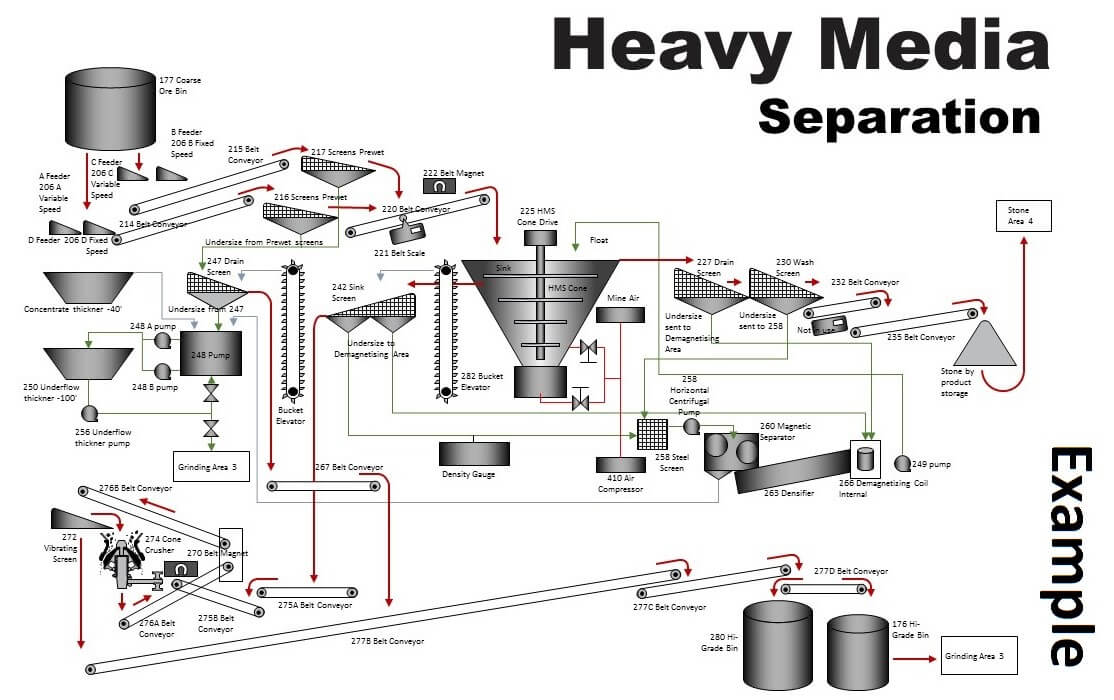
Sink and Float Process DESCRIPTION
The separation achieved in the H. H. Sink and Float Process is obtained by using:
- Apparatus which carries out its necessary function of removing separated products with a minimum of disturbance of the medium.
- Medium of high kinetic stability.
Apparatus: The apparatus used for the separation is shown above in Figure I. The ore is fed by chute (1) into the separating vessel (2) which is mainly an inverted truncated pyramid. The top sides are vertical and it is in the zone enclosed by these vertical sides that separation takes place. On top of these vertical sides are four paddles (3), having horizontal shafts and each extending completely across the separating zone. The paddle on the right in the figure is of smaller diameter than the others and revolves about twice as fast; its function being to insure that all the ore feed is completely immersed in the medium. The two center paddles are transporting paddles; they dip slightly into the medium at the bottom of each revolution and move the float slowly across the bath. The paddle on the left in the figure is the float discharge paddle; it receives the float and pushes it, together with a certain amount of medium, over the edge of the separator.
The bottom of the separating vessel is connected to the boot of the bucket elevator (4). The ore which sinks below the paddles gradually falls to the boot of the elevator and is dredged up by the buckets. The buckets are perforated and lift the ore a few feet above the medium level so that the medium in the buckets drains out before the sink product is discharged from the buckets. In the side of the elevator casing an opening is made at the medium level and fitted with an adjustable weir (5) for drawing of medium and controlling medium level.
Medium: The medium is a water suspension of a high density material such as galena. High kinetic stability can be achieved by fine grinding, but such a suspension could not be sufficiently fluid for the ore particles to move freely in their separation. On the other hand, an excess of coarse particles yields a high fluidity of the medium, but such a medium is not stable without a stirring device to prevent settling out. In the H. H. Sink and Float Process optimum fluidity and stability are achieved through control of size distribution of the medium particles and without any stirring or agitation of the medium.
Although the medium has high kinetic stability, there is naturally a tendency to settle out, for which due compensation is provided. To counteract this incipient settling, a small flow of medium is drawn over the weir (5) in the elevator casing. This flow is controlled by adjusting the weir height and is held so that it is just sufficient to withdraw the medium which is beginning to settle out at the bottom of the separator.
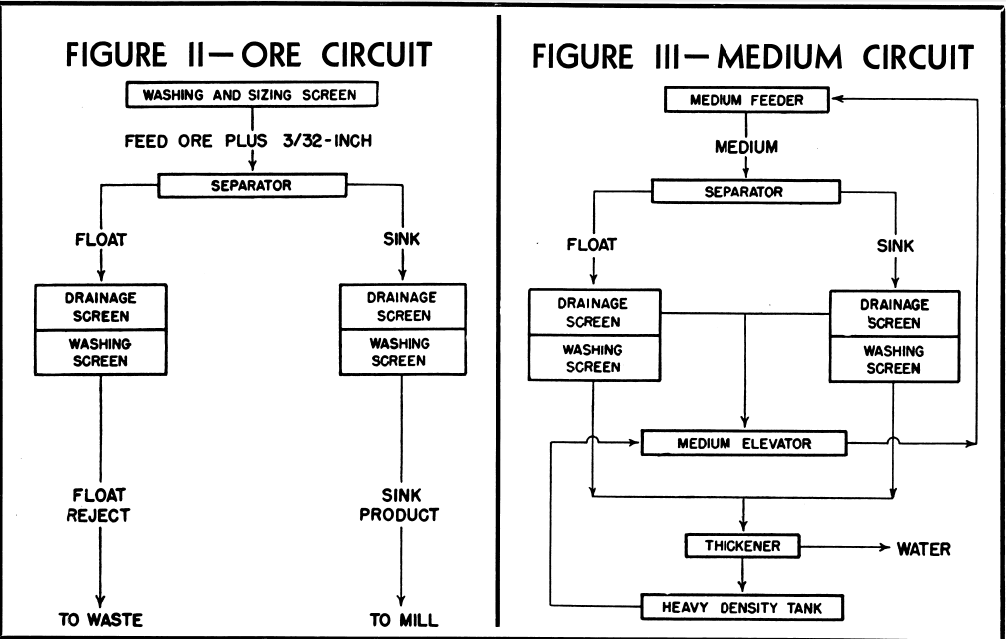
Thus, medium is flowing out of the separator at two points, namely at the elevator weir and at the float discharge. Medium is fed into the separator at a controlled rate equal to the two discharges; one with the float reject and the other over the weir. The medium which is fed into the separator consists of a mixture of these two flows of medium emerging from the separator. The medium is actually slowly circulating, first into the separator, then out at two points and then back into the separator. The rate of circulation equals the replacement of the entire contents of the separator in 20 to 40 minutes.
The high kinetic stability of the medium, combined with the slow withdrawal of medium from the bottom of the separator, yields a small difference in density (in practice only 0.2) between the feed medium and the medium at the bottom of the separator. This is an important factor as it prevents an increase in medium density downward from separating zone to bottom of separator to a degree sufficient to cause a piece of sink product, once separated near the top, to be prevented from sinking further down. The conditions of low density differentials in the H. H. Separator permit all sink products to reach the bottom of the separator and to be dredged up and discharged by the sink elevator.
OPERATING CIRCUITS
The foregoing has described the principles underlying the design and operation of the Sink and Float Separator. The manner in which the plant is operated in practice is shown above. The ore circuit and the medium circuit are shown separately for clarity, though actually they link up together.
Ore Circuit: Figure II illustrates the ore circuit. The ore, crushed to all pass 1½-inch, is fed at a regular rate to the washing and sizing screen, where 3/32-inch ore and slime are removed. From there the coarse ore goes to a slow-moving, inclined drainage conveyor, which removes surplus water and also acts as a feeder to the separator (2). The separated float and sink products are removed from the separator, as described above, to drainage and washing screens (6). On the drainage screens the free medium is first drained off for return to the separator. Then the medium adhering to the float and the sink is washed off on the washing screens, leaving the float ready for rejection and the sink for any further processing that may be necessary.
Medium Circuit: The medium circuit is shown above in Figure III. The medium of near operating density, which drains from the first of the screens, is returned by an elevator to the separator. The medium diluted by the washing process on the second of the screens is sent to a thickener. This overflows clear water which may be used again, and delivers as underflow a medium of extra heavy density. This density is maintained and controlled by the operation of a diaphragm pump which delivers the thickened medium to a stock tank. From this stock tank the extra heavy medium is fed to the medium elevator at the rate required to maintain the correct medium density in the operating circuit.
There are two other operations necessary to maintain the medium in good condition. The medium becomes contaminated with ore in a granular and in a slime condition, owing to the impossibility of completely freeing the original ore feed from these materials. The accumulation of these materials in the medium causes deterioration of both stability and fluidity and they must be removed. The granular portion is removed by means of a fine screen in the medium circuit. The finer contaminant is removed by “bleeding off” a portion of the medium, cleaning it by flotation, and returning the cleaned material to the circuit. The manner in which the medium is bled off and returned to the circuit depends on what is most convenient for the particular operation—the necessity is simply to maintain the operating medium in a sufficiently uncontaminated condition. Often the washings are used as feed for a cleaning operation and the cleaned material is brought to the necessary density either independently in a small filter or in the thickener.
The second operation is the provision of new make-up medium. This is required to compensate for the small loss of medium left adhering to the products after final washing and for the need of replacing worn medium. The loss on the products depends upon the nature of the ore, but is small. A loss of only 0.1 lb. of medium per ton of product has been attained. The replacement of worn medium is necessary periodically, but is not a loss. The necessary portion is extracted from the circuit in a high grade condition and is ready for sale at the full market price; an equivalent quantity of newly prepared medium takes its place in the circuit.
The preparation of new medium consists of normal grinding and classification processes. The grinding and classifying are carried out in such a manner that the necessary size distribution is obtained in the material sent to the medium circuit.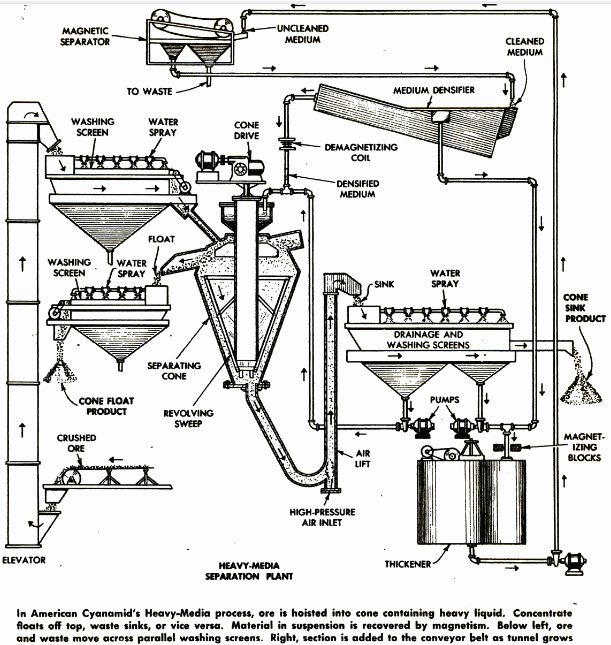
COMMERCIAL Sink and Float PLANTS
At least 4 commercial H. H. Sink and Float plants, had a capacity to treat more than 1,000,000 tons annually, have been constructed:
- Halkyn United District Mines, Ltd., North Wales, Great Britain
- Miniere Cave di Predil, Raibl, Italy
- Central European Mines, Mezica, Jugo-Slavia
- Bunker Hill and Sullivan Mining and Concentrating Company, Kellogg, Idaho
Today, the Nystar East Tennessee plant runs at 2,000,000 or so TPY.
Two more plants are under construction in the United States with a combined capacity of a further 1,500,000 tons annually.
As for example, the H. H. Sink and Float unit installed by Bunker Hill was designed to handle 1,700 tons per day and has actually treated ore at the rate of over 2,000 tons per day for consecutive days. The size of the separator is 8 ft. by 9 ft.
The plant commenced operations in November, 1941. It was preceded by extensive pilot plant testing, of which the following is a typical result:

Recent results for a month’s operation of the commercial plant show:

The Sink and Float separator at Bunker Hill receives about 70 percent of the mine ore of sizes ranging from 1¼-inch to 1/8-inch. It rejects as unneconomic coarse waste about 50 percent of the separator feed, or in other words, about 35 percent of the whole mine output. The remaining 65 percent of the mine ore, made up of 30 percent fines and 35 percent sink product, is further crushed, ground and concentrated in the mill proper.
On the basis of a mill handling 1,000 tons daily before the installation of Sink and Float, it is possible to handle 1,500 tons of mine ore with Sink and Float. After rejection of 500 tons as float the unit returns 1,000 tons to the mill. In other words, the mill output is substantially increased through the elimination of a sizeable portion of gangue from the mine ore before milling.
The feed may contain some disseminated values. By raising or lowering the density of the separating medium, more or less of these disseminated values appear in the float product. Thus within limits the tailing assay from the Sink and Float operation can be raised or lowered in a controlled manner with, of course, an increase or decrease respectively in the proportion of such tailings produced. The alteration in the proportion of Sink and Float tailings affects the subsequent milling capacity and costs. It is therefore possible to control the medium density in the Sink and Float operation to give the best economic balance between tailing assay and total milling costs.
Operating Cost of Sink & Float Plants
Labor: For operating the separator, together with the medium circuit, two operators per shift are usually required for either a large or small plant.
Power: Power consumption varies with the size of the plant. For a 1,500 to 2,000 tons per day plant the consumption is 0.7 kwh per ton of mine ore.
Water: Consumption of water is extremely low. The only loss of water, aside from climatic evaporation, is the water carried away as moisture adhering to the products leaving the plant.This can be reduced to less than 10 gallons per ton of ore treated.
The water used in washing medium off the sink and float products is recovered as thickener overflow. This is sufficient in amount for the primary washing of the ore. Where the products of the Sink and Float treatment are further processed by standard milling techniques, this amount of water would have been added to the mill feed even without Sink and Float treatment.
The total water plus fines plus sink product constitute in an average case a pulp carrying 70 to 75 percent solids, so that the introduction of the Sink and Float treatment does not lead to any additional water consumption.
Maintenance: No heavy maintenance costs are incurred. The main items requiring replacement are screen plates and sink elevator parts.
Capital Cost: The cost of an installation depends materially on its size and location. Under normal conditions the cost of equipment, exclusive of installation and housing, would be from $15 to $35 per ton of daily capacity depending on the size of the plant.
When is a Sink & Float Process Applicable or Appropriate
The process may be used for pre-treatment of certain ores, both metallic and non-metallic, with the object of reducing over-all treatment costs, reducing over-all installation costs and increasing ultimate mill capacity without large capital expenditures.
It may be used to permit cheaper, non-selective methods of mining, since wall rock and low grade ore can be cheaply handled with good recoveries. It may be used for preliminary reclamation of values in tailing dumps.
It may be used to make a salable product, in the case of some non-metallic ores, and where necessary excessive treatment of refractory or friable metallic ores leads to heavy losses.
Sink and Float treatment is not confined to lead and zinc ores or to those ores suitable only for jigging or tabling. Provided a substantial proportion of uneconomic gangue is freed at a coarse size, it may be removed from the ore by Sink and Float treatment regardless of the subsequent treatment necessary to free and recover the values.
SINK FLOAT TEST PROCEDURE
Sink float tests aid in the evaluation of products, identification of minerals and give approximate separation of gangue minerals. Sink Float Concentration is used in mineral dressing laboratories for:
- Separation of samples into different specific gravities to aid in the identification of minerals.
- Determining the separation which can be made between the heavier minerals and lighter gangue minerals.
- Evaluation of products by separating into sink and float fractions.
Sink-Float Tests are classed as bulk or selective separations. A bulk test gives two products, first, the lighter minerals with a gravity less than 2.8 to 3.3 and, second, minerals having a gravity heavier than 2.8 to 3.3. The separation depends on the gravity of the media used.
The heavy media generally used are as follows:
- Acetylene Tetrabromide having a specific gravity of 2.964 at 20°C.
- Methylene Iodide, having a specific gravity of 3.3 at 20°C.
Tests on samples plus 10 mesh are made by adding a weighed slime free sample to the media, stirring and ladling the float off with a spoon or a screen ladle. The sink product is recovered by decanting off the heavy liquid.
Tests on fine sized products are made by using a separatory funnel. The sink product is the drawoff.
A selective sink float separation can be made by removing the heaviest minerals as a sink product and adding a sufficient amount of diluting media, such as carbon tetrachloride to acetylene tetrabromide, to give the desired lower gravity. This will allow the next heavier minerals to separate as a sink product. Recovery of the media for reuse may be by virtue of different boiling points or miscibility in other liquids.
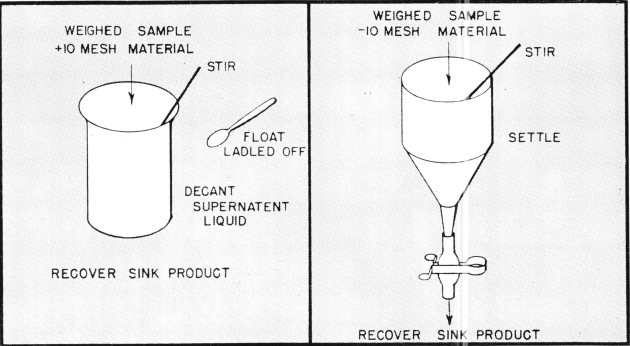
Here below from the Popular Mechanics.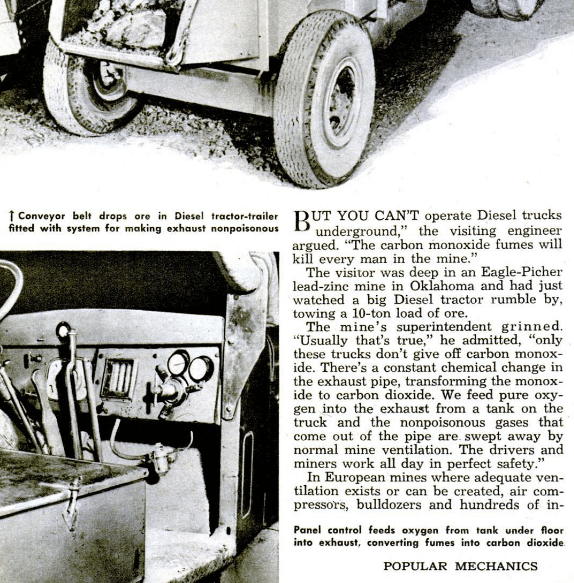
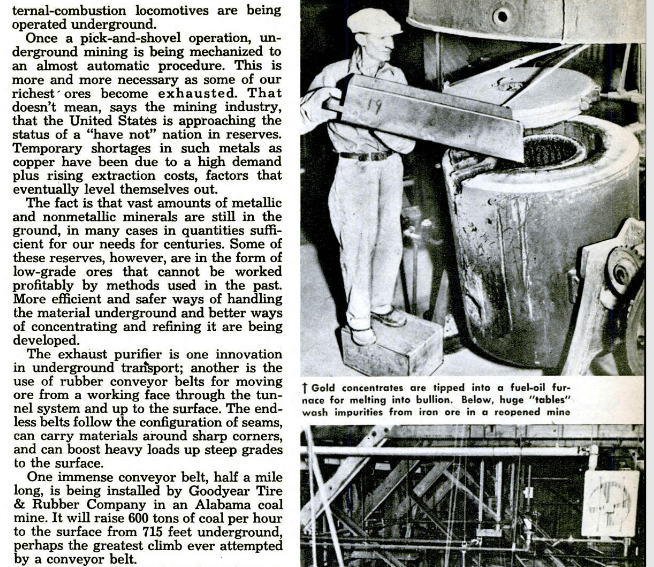
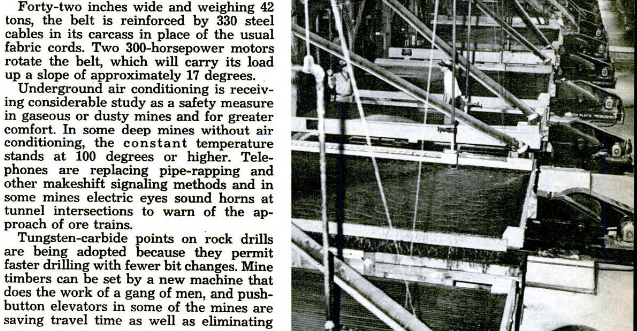
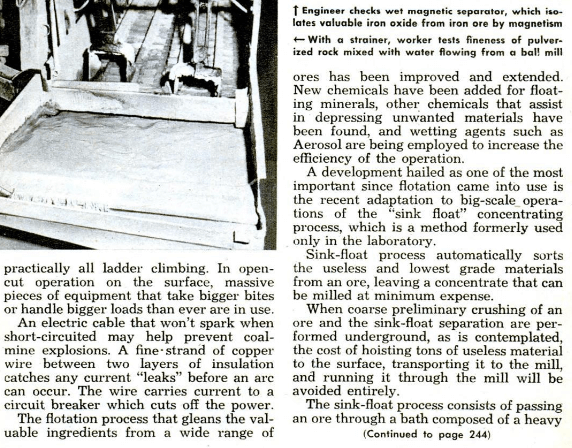
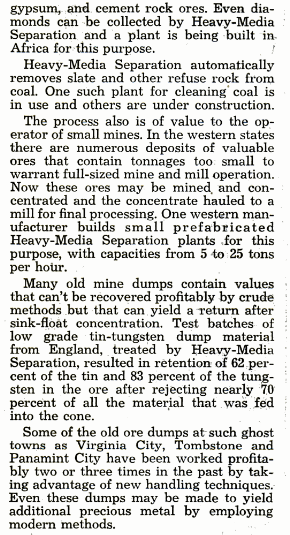
Source: This article is a reproduction of an excerpt of “In the Public Domain” documents held in 911Metallurgy Corp’s private library.

